2020年普通高等学校招生全国统一考试英语(全国I卷)(含答案)
2020年普通高等学校招生全国统一考试英语试题(新课标1卷,含解析)

2020年普通高等学校招生全国统一考试英语试题(新课标1卷,含解析)注意事项:1. 本试卷分第Ⅰ卷(选择题)和第Ⅱ卷(非选择题)两部分。
第Ⅰ卷1页至10页,第Ⅱ卷11页至13页。
2. 答题前,考生务必将自己的姓名,准考证号填写在本试卷相应的位置。
3. 全部答案在答题卡上完成,搭载本试卷上无效。
4. 第Ⅰ卷听力部分满分30分,不计入总分,考试成绩录取时提供给高校作参考。
5. 考试结束后,将本试卷和答题卡一并交回。
第Ⅰ卷第一部分听力(共两节,满分30分)做题时,现将答案标在试卷上,录音内容结束后,你将有两分钟的时间将试卷上的答案转涂到答题卡上。
第一节(共5小题;每小题1.5分,满分7.5分)(略)听下面5段对话,每段对话后有一个小题。
从题中所给的A,B,C三个选项中选出最佳选项,并标在试卷的相应位置。
听完每段对话后,你都有10秒钟的时间来回答有关小题和阅读下一小题。
每段对话仅读一遍。
例: How much is the shirt?A.£ 19.15B.£ 9.18C.£ 9.15答案是C。
第二部分阅读理解(共两节,满分60分)第一节(共15小题;每小题3分,满分45分)阅读下列短文,从每题所给的四个选项(A、B、C、和D)中,选出最佳选项,并在答题卡上将该项涂黑。
AMonthly Talks at London Canal MuseumOur monthly talks start at 19:30 on the first Thursday of each month except August. Admission is at normal charges and you don’t need to book. Th ey end around 21:00.November 7thThe Canal Pioneers, by Chris Lewis. James Brindley is recognized as one of the leading early canal engineers. He was also a major player in training others in the art of nanal planning and building. Chris Lewis will explain how Brindley made such a positive contribution to the education of that group of early “civil enginerrs”.December 5thIce for the Metropolis, by Malcolm Tucker. Well before the arrival of freezers, there was a demand for ice for food preservation and catering, Malcolm will explain the history of importing natural ice and the technology of building ice wells, and how London’s ice trade grew.February 6thAn Update on the Cotsword Canals, by Liz Payne. The Smoudwater Canal is moving towards reopenling. The Thames and Severn Canal will take a little longer. We will have a report on the present state of play.March 6thEyots and Aits- Thames Islands, by Miranda Vickers. The Thames had many islands. Miranda has undertaken a review of all of them. She will tell us about those of greatest interest.Online bookings:/bookMore into:/whatsonLondon Canal Museum12-13 New Wharf Road, London NI 9RT www.canalmuseum.mobiTel:020 ********21.When is the talk on James Brindley?A. February 6th.B. March 6th.C. November 7th.D. December 5th.22. What is the topic of the talk in February?A. The Canal Pioneers.B. Ice for the MetropolisC. Eyots and Aits- Thames IslandsD. An Update on the Cotsword Canals23. Who will give the talk on the islands in the Thames.A. Miranda VickersB. Malcolm TuckerC. Chris LewisD. Liz PayneBThe freezing Northeast hasn’t been a terribly fun place to spend time this winter, so when the chance came for a weekend to Sarasota, Florida, my bags were packed before you could say “sunshine”. I left for the land of warmth and vitamin C(维生素C), thinking of beaches and orange trees. When we touched down to blue skies and warm air, I sent up a small prayer ofgratefulness. Swimming pools, wine tasting, and pink sunsets(at normal evening hours, not 4 in the afternoon) filled the weekend, but the best part- particularly to my taste, dulled by months of cold- weather root vegetables- was a 7 a.m. adventure to the Sarasota farmers’ market that proved to be more than worth the early wake-up call.The market, which was founded in 1979, sets up its tents every Saturday from 7:00 am to 1 p.m, rain or shine, along North Lemon and State streets. Baskets of perfect red strawberries, the red-painted sides of the Java Dawg coffee truck; and most of all, the tomatoes: amazing, large, soft and round red tomatoes.Disappointed by many a broken, vine-ripened(蔓上成熟的) promise, I’ve refused to buy winter tomatoes for years. No matter how attractive they look in the store, once I get them home they’re unfailingly dry, hard, and tasteless. But I homed in, with uncertainty, on one particular table at the Brown’s Grove Farm’s stand, full of fresh and soft tomatoes the size of my fist. These were the real deal- and at that moment, I realized that the best part of Sarasota in winter was going to be eating things that back home in New York I wouldn’t be experiencing again for months.Delighted as I was by the tomatoes in sight, my happiness deepened whenI learned that Brown’s Grove Farm is one of the suppliers for Jack Dusty,a newly opened restaurant at the Sarasota Ritz Carlton, where- luckily for me- I was planning to have dinner that very night. Without even seeing the menu, I knew I’d be ordering every tomato on it.24. What did the author think of her winter life in New York?A. Exciting.B. Boring.C. Relaxing.D. Annoying.25. What made the author’s getting up late early worthwhile?A. Having a swim.B. Breathing in fresh air.C. Walking in the morning sun.D. Visiting a local farmer’s market.26. What can we learn about tomatoes sold in New York in winter?A. They are soft.B. They look nice.C. They taste great.D. They are juicy.27. What was the author going to that evening?A. Go to a farm.B. Check into a hotel.C. Eat in a restaurant.D. Buy fresh vegatables.CSalvador Dali (1904-1989) was one of the most popular of modern artists. The Pompidou Centre in Paris is showing its respect and admiration for the artist and his powerful personality with an exhibition bringing together over 200 paintings, sculptures, drawings and more. Among the works and masterworks on exhibition the visitor will find the best pieces, most importantly The Persistence of Memory. There is also L’Enigme sans Fin from 1938, works on paper, objects, and projects for stage and screen and selected parts from television programmes refl ecting the artist’s showman qualities.The visitor will enter the World of Dali through an egg and is met with the beginning, the world of birth. The exhibition follows a path of time and subject with the visitor exiting through the brain.The exhibition shows how Dali draws the viewer between two infinities (无限). “From the infinity small to the infinity large, contraction and expansion coming in and out of focus: amazing Flemish accuracy and the showy Baroque of old painting that he used in his museum-thea tre in Figueras,” explains the Pompidou Centre.The fine selection of the major works was done in close collaboration (合作)with the Museo Nacional Reina Sofia in Madrid, Spain, and with contributions from other institutions like the Salvador Dali Museum in St. Petersburg.28. Which of the following best describe Dali according to Paragraph 1?A. Optimistic.B. ProductiveC. Generous.D. Traditional.29. What is Dali’s The Persistence of Memory considered to be?A. One of his masterworks.B. A successful screen adaptation.C. An artistic creation for the stage.D. One of the beat TV programmes.30. How are the exhibits arranged at the World of Dali?A. By popularity.B. By importance.C. By size and shape.D. By time and subject.31. What does th e word “contributions” in the last paragraph refer to?A. Artworks.B. Projects.C. Donations.D. Documents.DConflict is on the menu tonight at the café La Chope. This evening, as on every Thursday night, psychologist Maud Lehanne is leading two of France’s favorite pastimes, coffee drinking and the “talking cure”. Here they are learning to get in touch with their true feelings. It isn’t always easy. They customers-some thirty Parisians who pay just under $2 (plus drinks) per session-care quick to intellectualize (高谈阔论),slow to open up and connect. “You are forbidden to say ‘one feels,’ or ‘people think’,”Lehane told them. “Say ‘I think,’ ‘Think me’.”A café society where no intellectualizing is allowed? It couldn’t seem more un-French. But Lehanne’s psychology café is about more than knowing oneself: It’s trying to help the city’s troubled neighborhood cafes. Over the years, Parisian cafes have fallen victim to changes in the French lifestyle-longer working hours, a fast food boom and a you nger generation’s desire to spend more time at home. Dozens of new theme cafes appear to change the situation. Cafes focused around psychology, history, and engineering are catching on, filling tables well into the evening.32.What are people encouraged to do at the cafe La Chope?A. Learn a new subjectB. Keep in touch with friends.C. Show off their knowledge.D. Express their true feelings.33. How are cafes affected by French lifestyle changes?A. They are less frequently visited.B. They stay open for longer hours.C. They have bigger night crowds.D. They start to serve fast food.34. What are theme cafes expected to do?A. Create more jobs.B. Supply better drinks.C. Save the cafe business.D. Serve the neighborhood.35. Why are psychology cafes becoming popular in Paris?A. They bring people true friendship.B. They give people spiritual support.C. They help people realize their dreams.D. They offer a platform for business links.D篇.文章大意:文章主要讲述了精神咖啡馆在法国越来越受欢迎。
2020年普通高等学校招生全国统一考试英语(全国卷I,解析版)
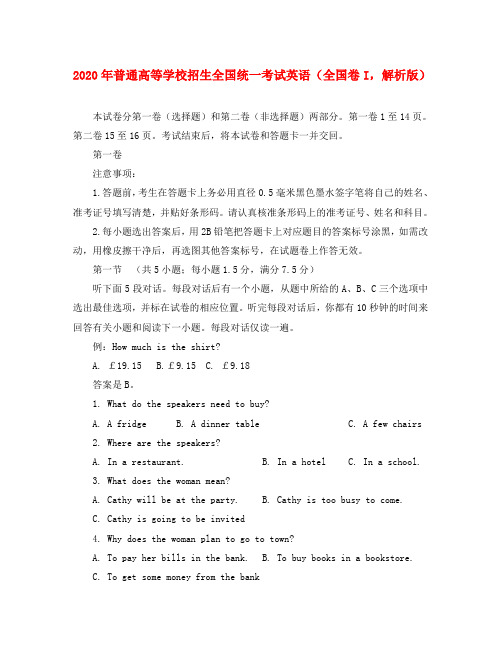
2020年普通高等学校招生全国统一考试英语(全国卷I,解析版)本试卷分第一卷(选择题)和第二卷(非选择题)两部分。
第一卷1至14页。
第二卷15至16页。
考试结束后,将本试卷和答题卡一并交回。
第一卷注意事项:1.答题前,考生在答题卡上务必用直径0.5毫米黑色墨水签字笔将自己的姓名、准考证号填写清楚,并贴好条形码。
请认真核准条形码上的准考证号、姓名和科目。
2.每小题选出答案后,用2B铅笔把答题卡上对应题目的答案标号涂黑,如需改动,用橡皮擦干净后,再选图其他答案标号,在试题卷上作答无效。
第一节(共5小题;每小题1.5分,满分7.5分)听下面5段对话。
每段对话后有一个小题,从题中所给的A、B、C三个选项中选出最佳选项,并标在试卷的相应位置。
听完每段对话后,你都有10秒钟的时间来回答有关小题和阅读下一小题。
每段对话仅读一遍。
例:How much is the shirt?A. £19.15B.£9.15C. £9.18答案是B。
1. What do the speakers need to buy?A. A fridgeB. A dinner tableC. A few chairs2. Where are the speakers?A. In a restaurant.B. In a hotelC. In a school.3. What does the woman mean?A. Cathy will be at the party.B. Cathy is too busy to come.C. Cathy is going to be invited4. Why does the woman plan to go to town?A. To pay her bills in the bank.B. To buy books in a bookstore.C. To get some money from the bank5. What is the woman trying to do?A. Finish some writing.B. Print an article.C. Find a newspaper.第二节(共15小题,每小题1.5分,满分22.5分)听下面5段对话或独白。
2020年高考真题——英语(全国卷Ⅰ)+Word版含答案
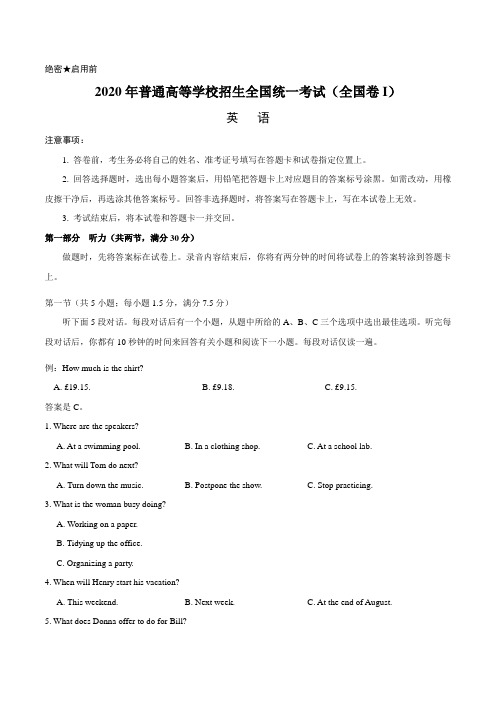
绝密★启用前2020年普通高等学校招生全国统一考试(全国卷I)英语注意事项:1. 答卷前,考生务必将自己的姓名、准考证号填写在答题卡和试卷指定位置上。
2. 回答选择题时,选出每小题答案后,用铅笔把答题卡上对应题目的答案标号涂黑。
如需改动,用橡皮擦干净后,再选涂其他答案标号。
回答非选择题时,将答案写在答题卡上,写在本试卷上无效。
3. 考试结束后,将本试卷和答题卡一并交回。
第一部分听力(共两节,满分30分)做题时,先将答案标在试卷上。
录音内容结束后,你将有两分钟的时间将试卷上的答案转涂到答题卡上。
第一节(共5小题;每小题1.5分,满分7.5分)听下面5段对话。
每段对话后有一个小题,从题中所给的A、B、C三个选项中选出最佳选项。
听完每段对话后,你都有10秒钟的时间来回答有关小题和阅读下一小题。
每段对话仅读一遍。
例:How much is the shirt?A. £19.15.B. £9.18.C. £9.15.答案是C。
1. Where are the speakers?A. At a swimming pool.B. In a clothing shop.C. At a school lab.2. What will Tom do next?A. Turn down the music.B. Postpone the show.C. Stop practicing.3. What is the woman busy doing?A. Working on a paper.B. Tidying up the office.C. Organizing a party.4. When will Henry start his vacation?A. This weekend.B. Next week.C. At the end of August.5. What does Donna offer to do for Bill?A. Book a flight for him.B. Drive him to the airport.C. Help him park the car.第二节(共15小题;每小题1.5分,满分22.5分)听下面5段对话或独白。
2020年高考真题——英语(全国卷Ⅰ) 无听力部分Word版含答案
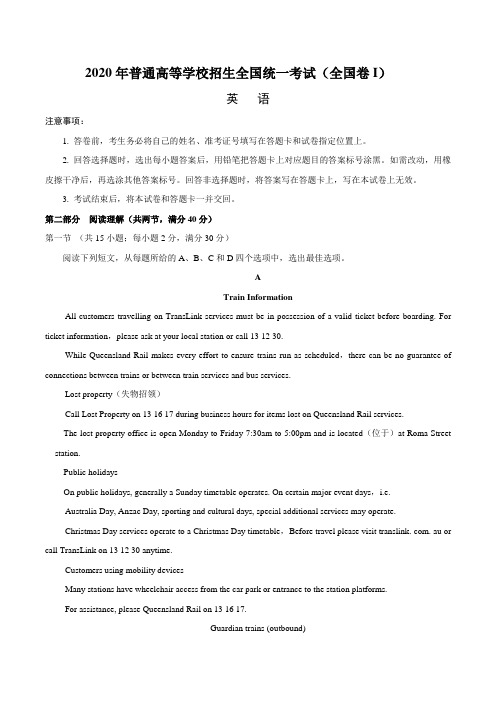
2020年普通高等学校招生全国统一考试(全国卷I)英语注意事项:1. 答卷前,考生务必将自己的姓名、准考证号填写在答题卡和试卷指定位置上。
2. 回答选择题时,选出每小题答案后,用铅笔把答题卡上对应题目的答案标号涂黑。
如需改动,用橡皮擦干净后,再选涂其他答案标号。
回答非选择题时,将答案写在答题卡上,写在本试卷上无效。
3. 考试结束后,将本试卷和答题卡一并交回。
第二部分阅读理解(共两节,满分40分)第一节(共15小题;每小题2分,满分30分)阅读下列短文,从每题所给的A、B、C和D四个选项中,选出最佳选项。
ATrain InformationAll customers travelling on TransLink services must be in possession of a valid ticket before boarding. For ticket information,please ask at your local station or call 13 12 30.While Queensland Rail makes every effort to ensure trains run as scheduled,there can be no guarantee of connections between trains or between train services and bus services.Lost property(失物招领)Call Lost Property on 13 16 17 during business hours for items lost on Queensland Rail services.The lost property office is open Monday to Friday 7:30am to 5:00pm and is located(位于)at Roma Street station.Public holidaysOn public holidays, generally a Sunday timetable operates. On certain major event days,i.e.Australia Day, Anzac Day, sporting and cultural days, special additional services may operate.Christmas Day services operate to a Christmas Day timetable,Before travel please visit translink. com. au or call TransLink on 13 12 30 anytime.Customers using mobility devicesMany stations have wheelchair access from the car park or entrance to the station platforms.For assistance, please Queensland Rail on 13 16 17.Guardian trains (outbound)21. What would you do get ticker information?A. Call 13 16 17.B. Visit translink .com.au.C. Ask at the local station.D. Check the train schedule.22. At which station can you find the lost property office?A. Altandi.B. Roma Street.C. Varsity Lakes.D. Fortitude Valley.23. Which train would you take if you go from Central to Varsity Lakes?A.6:42 pm.B.7:29 pm.C.8:57 pm.D.11:02 pm.BReturning to a book you’ve read many times can feel like drinks with an old friend. There’s a welcome familiarity —but also sometimes a slight suspicion that time has changed you both, and thus the relationship. But books don’t change, people do. And that’s what makes the act of rereading so rich and transformative.The beauty of rereading lies in the idea that our bond with the work is based on our present mental register. It’s true, the older I get, the more I feel time has wings. But with reading, it’s all about the present. It’s about the now and what one contributes to the now, because reading is a give and take between author and reader. Each has to pull their own weight.There are three books I reread annually The first, which I take to reading every spring is Eme st Hemningway’s A Moveable Feast. Published in 1964, it’s his classic memoir of 1920s Paris. The language is almost intoxicating (令人陶醉的),an aging writer looking back on an ambitious yet simpler time. Another is Annie Dillard’s Holy the Firm, her poetic 1975 ramble (随笔) about everything and nothing. The third book is Julio Cortazar’s Save Twilight: Selected Poems, because poetry. And because Cortazar.While I tend to buy a lot of books, these three were given to me as gifs, which might add to the meaning I attach to them. But I imagine that, while money is indeed wonderful and necessary, rereading an author’s work is the highest currency a reader can pay them. The best books are the ones that open further as time passes. Butremember, it’s you that has to gr ow and read and reread in order to better understand your friends.24. Why does the author like rereading?A. It evaluates the writer-reader relationship.B. It’s a window to a whole new world.C. It’s a substitute for drinking with a friend.D. It extends the understanding of oneself.25. What do we know about the book A Moveable Feas!?A. It’s a brief account of a trip.B. It’s about Hemingway’s life as a young man.C. It’s a record of a historic event.D. It’s about Hemingway’s friends in Paris.26. What does the underlined word "currency"in paragraph 4 refer to?A. DebtB. Reward.C. Allowance.D. Face value.27. What can we infer about the author from the text?A. He loves poetry.B. He’s an editor.C. He’s very ambitious.D. He teaches reading.CRace walking shares many fitness benefits with running, research shows, while most likely contributing to fewer injuries. It does, however, have its own problem.Race walkers are conditioned athletes. The longest track and field event at the Summer Olympics is the 50-kilometer race walk, which is about five miles longer than the marathon. But the sport’s rules require that a race walker’s knees stay straight through most of the leg swing and one foot remain in contact (接触) with the ground at all times. It’s thi s strange form that makes race walking such an attractive activity, however, says Jaclyn Norberg, an assistant professor of exercise science at Salem State University in Salem, Mass.Like running, race walking is physically demanding, she says, According to most calculations, race walkersmoving at a pace of six miles per hour would burn about 800 calories(卡路里) per hour, which is approximately twice as many as they would burn walking, although fewer than running, which would probably burn about 1,000 or more calories per hour.However, race walking does not pound the body as much as running does, Dr. Norberg says. According to her research, runners hit the ground with as much as four times their body weight per step, while race walkers, who do not leave the ground, create only about 1.4 times their body weight with each step.As a result, she says, some of the injuries associated with running, such as runner’s knee, are uncommon among race walkers. But the sport’s strange form does place considerable stress o n the ankles and hips, so people with a history of such injuries might want to be cautious in adopting the sport. In fact, anyone wishing to try race walking should probably first consult a coach or experienced racer to learn proper technique, she says. It takes some practice.28. Why are race walkers conditioned athletes?A. They must run long distances.B. They are qualified for the marathon.C. They have to follow special rules.D. They are good at swinging their legs.29. What advantage does race walking have over running?A. It’s more popular at the Olympics.B. It’s less challenging physically.C. It’s more effective in body building.D. It’s less likely to cause knee injuries.30 What is Dr. Norberg’s suggestion for someone trying race walking?A. Get ting experts’ opinions.B. Having a medical checkup.C. Hiring an experienced coach.D. Doing regular exercises.31. Which word best describes the author’s attitude to race walking?A. Skeptical.B. Objective.C. Tolerant.D. Conservative.DThe connection between people and plants has long been the subject of scientific research. Recent studies have found positive effects. A study conducted in Youngstown,Ohio,for example, discovered that greener areas of the city experienced less crime. In another,employees were shown to be 15% more productive when their workplaces were decorated with houseplants.The engineers at the Massachusetts Institute of Technology(MIT)have taken it a step further changing the actual composition of plants in order to get them to perform diverse,even unusual functions. These include plants that have sensors printed onto their leaves to show when they’re short of water and a plant that can detect harmful chemicals in groundwater. "We’re thinking about how we can engineer plants to replace functions of the things that we use every day,"explained Michael Strano, a professor of chemical engineering at MIT.One of his latest projects has been to make plants grow(发光)in experiments using some common vegetables. Strano’s team found tha t they could create a faint light for three-and-a-half hours. The light,about one-thousandth of the amount needed to read by,is just a start. The technology, Strano said, could one day be used to light the rooms or even to turn tree into self-powered street lamps.in the future,the team hopes to develop a version of the technology that can be sprayed onto plant leaves in a one-off treatment that would last the plant’s lifetime. The engineers are also trying to develop an on and off"switch"where the glow would fade when exposed to daylight.Lighting accounts for about 7% of the total electricity consumed in the US. Since lighting is often far removed from the power source(电源)—such as the distance from a power plant to street lamps on a remote highway-a lot of energy is lost during transmission(传输).Glowing plants could reduce this distance and therefore help save energy.32. What is the first paragraph mainly about?A. A new study of different plants.B. A big fall in crime rates.C. Employees from various workplaces.D. Benefits from green plants.33. What is the function of the sensors printed on plant leaves by MIT engineer?A. To detect plants’ lack of waterB. To change compositions of plantsC. To make the life of plants longer.D. To test chemicals in plants.34. What can we expect of the glowing plants in the future?A. They will speed up energy production.B. They may transmit electricity to the home.C. They might help reduce energy consumption.D. They could take the place of power plants.35. Which of the following can be the best title for the text?A. Can we grow more glowing plants?B. How do we live with glowing plants?C. Could glowing plants replace lamps?D. How are glowing plants made pollution-free?第二节(共5小题;每小题2分,满分10分)根据短文内容,从短文后的选项中选出能填入空白处的最佳选项。
2020年高考英语全国一卷(精校+答案+听力原文)
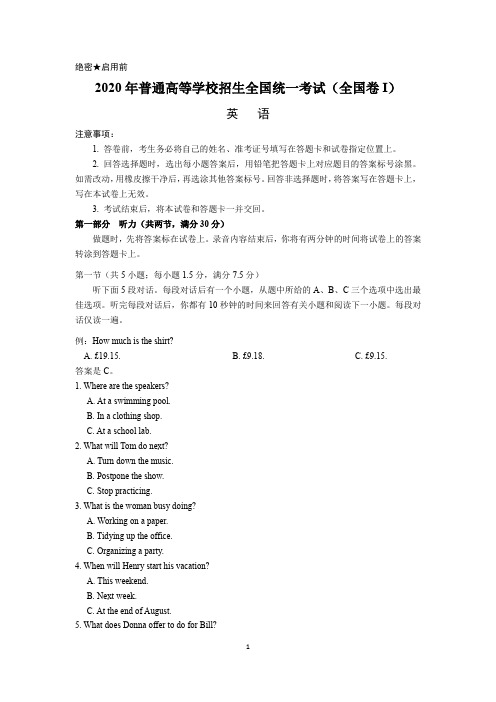
绝密★启用前2020年普通高等学校招生全国统一考试(全国卷I)英语注意事项:1. 答卷前,考生务必将自己的姓名、准考证号填写在答题卡和试卷指定位置上。
2. 回答选择题时,选出每小题答案后,用铅笔把答题卡上对应题目的答案标号涂黑。
如需改动,用橡皮擦干净后,再选涂其他答案标号。
回答非选择题时,将答案写在答题卡上,写在本试卷上无效。
3. 考试结束后,将本试卷和答题卡一并交回。
第一部分听力(共两节,满分30分)做题时,先将答案标在试卷上。
录音内容结束后,你将有两分钟的时间将试卷上的答案转涂到答题卡上。
第一节(共5小题;每小题1.5分,满分7.5分)听下面5段对话。
每段对话后有一个小题,从题中所给的A、B、C三个选项中选出最佳选项。
听完每段对话后,你都有10秒钟的时间来回答有关小题和阅读下一小题。
每段对话仅读一遍。
例:How much is the shirt?A. £19.15.B. £9.18.C. £9.15.答案是C。
1. Where are the speakers?A. At a swimming pool.B. In a clothing shop.C. At a school lab.2. What will Tom do next?A. Turn down the music.B. Postpone the show.C. Stop practicing.3. What is the woman busy doing?A. Working on a paper.B. Tidying up the office.C. Organizing a party.4. When will Henry start his vacation?A. This weekend.B. Next week.C. At the end of August.5. What does Donna offer to do for Bill?A. Book a flight for him.B. Drive him to the airport.C. Help him park the car.第二节(共15小题;每小题1.5分,满分22.5分)听下面5段对话或独白。
2020年普通高等学校招生全国统一考试英语试题(新课标卷,含答案)(1)
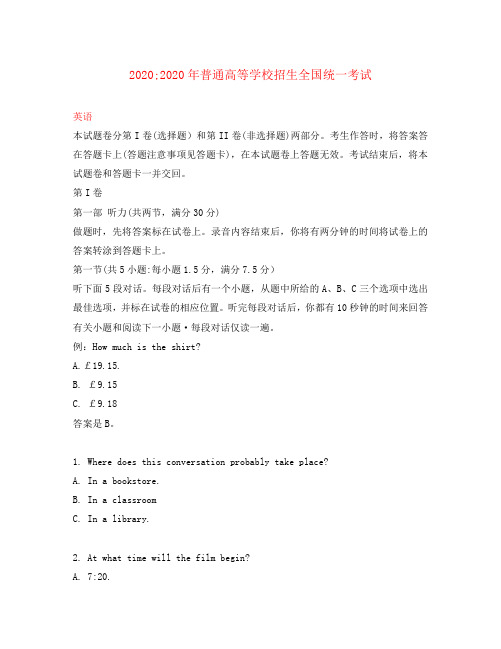
2020;2020年普通高等学校招生全国统一考试英语本试题卷分第I卷(选择题)和第II卷(非选择题)两部分。
考生作答时,将答案答在答题卡上(答题注意事项见答题卡),在本试题卷上答题无效。
考试结束后,将本试题卷和答题卡一并交回。
第I卷第一部听力(共两节,满分30分)做题时,先将答案标在试卷上。
录音内容结束后,你将有两分钟的时间将试卷上的答案转涂到答题卡上。
第一节(共5小题:每小题1.5分,满分7.5分)听下面5段对话。
每段对话后有一个小题,从题中所给的A、B、C三个选项中选出最佳选项,并标在试卷的相应位置。
听完每段对话后,你都有10秒钟的时间来回答有关小题和阅读下一小题·每段对话仅读一遍。
例:How much is the shirt?A.£19.15.B. £9.15C. £9.18答案是B。
1. Where does this conversation probably take place?A. In a bookstore.B. In a classroomC. In a library.2. At what time will the film begin?A. 7:20.C. 7:00.3. What are the two speakers mainly talking about?A.Their friend Jane.B. A weekend trip.C. A radio programme.4. What will the woman probably do?A. Catch a train.B. See the man off.C. Go shopping.i5. Why did the woman apologize?A. She made a late delivery.B. bne went to the wrong place.C. She couldn't take the cake back.第二节(共15小题:每小题1.5分,满分22.5分)听下面5段对话。
2020年普通高等学校招生全国统一考试英语(全国卷I,含答案)

2020年普通高等学校招生全国统一考试英语(全国卷I,含答案)本试卷分第一卷(选择题)和第二卷(非选择题)两部分。
第一卷1至14页。
第二卷15至16页。
考试结束后,将本试卷和答题卡一并交回。
第一卷注意事项:1.答题前,考生在答题卡上务必用直径0.5毫米黑色墨水签字笔将自己的姓名、准考证号填写清楚,并贴好条形码。
请认真核准条形码上的准考证号、姓名和科目。
2.每小题选出答案后,用2B铅笔把答题卡上对应题目的答案标号涂黑,如需改动,用橡皮擦干净后,再选图其他答案标号,在试题卷上作答无效。
第一节(共5小题;每小题1.5分,满分7.5分)听下面5段对话。
每段对话后有一个小题,从题中所给的A、B、C三个选项中选出最佳选项,并标在试卷的相应位置。
听完每段对话后,你都有10秒钟的时间来回答有关小题和阅读下一小题。
每段对话仅读一遍。
例:How much is the shirt?A. £19.15B.£9.15C. £9.18答案是B。
1. What do the speakers need to buy?A. A fridgeB. A dinner tableC. A few chairs2. Where are the speakers?A. In a restaurant.B. In a hotelC. In a school.3. What does the woman mean?A. Cathy will be at the party.B. Cathy is too busy to come.C. Cathy is going to be invited4. Why does the woman plan to go to town?A. To pay her bills in the bank.B. To buy books in a bookstore.C. To get some money from the bank5. What is the woman trying to do?A. Finish some writing.B. Print an article.C. Find a newspaper.第二节(共15小题,每小题1.5分,满分22.5分)听下面5段对话或独白。
2020年普通高等学校招生全国统一考试(英语全国卷I)(word附答案)
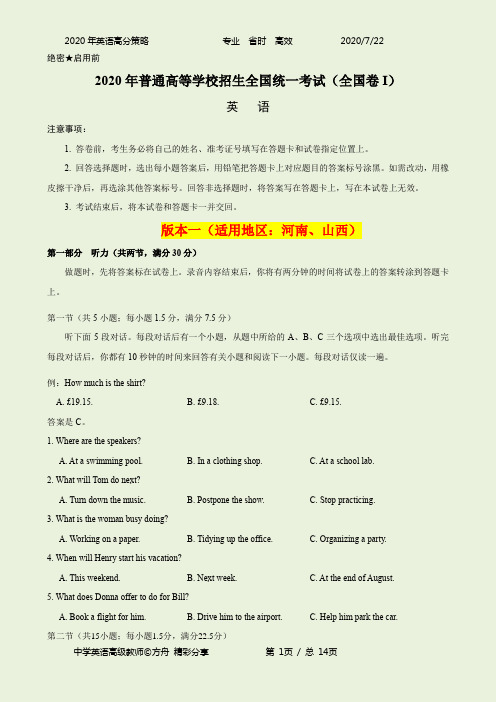
绝密★启用前2020年普通高等学校招生全国统一考试(全国卷I)英语注意事项:1. 答卷前,考生务必将自己的姓名、准考证号填写在答题卡和试卷指定位置上。
2. 回答选择题时,选出每小题答案后,用铅笔把答题卡上对应题目的答案标号涂黑。
如需改动,用橡皮擦干净后,再选涂其他答案标号。
回答非选择题时,将答案写在答题卡上,写在本试卷上无效。
3. 考试结束后,将本试卷和答题卡一并交回。
版本一(适用地区:河南、山西)第一部分听力(共两节,满分30分)做题时,先将答案标在试卷上。
录音内容结束后,你将有两分钟的时间将试卷上的答案转涂到答题卡上。
第一节(共5小题;每小题1.5分,满分7.5分)听下面5段对话。
每段对话后有一个小题,从题中所给的A、B、C三个选项中选出最佳选项。
听完每段对话后,你都有10秒钟的时间来回答有关小题和阅读下一小题。
每段对话仅读一遍。
例:How much is the shirt?A. £19.15.B. £9.18.C. £9.15.答案是C。
1. Where are the speakers?A. At a swimming pool.B. In a clothing shop.C. At a school lab.2. What will Tom do next?A. Turn down the music.B. Postpone the show.C. Stop practicing.3. What is the woman busy doing?A. Working on a paper.B. Tidying up the office.C. Organizing a party.4. When will Henry start his vacation?A. This weekend.B. Next week.C. At the end of August.5. What does Donna offer to do for Bill?A. Book a flight for him.B. Drive him to the airport.C. Help him park the car.第二节(共15小题;每小题1.5分,满分22.5分)听下面5段对话或独白。
2020年普通高等学校招生全国统一考试英语试题(全国卷,含答案)
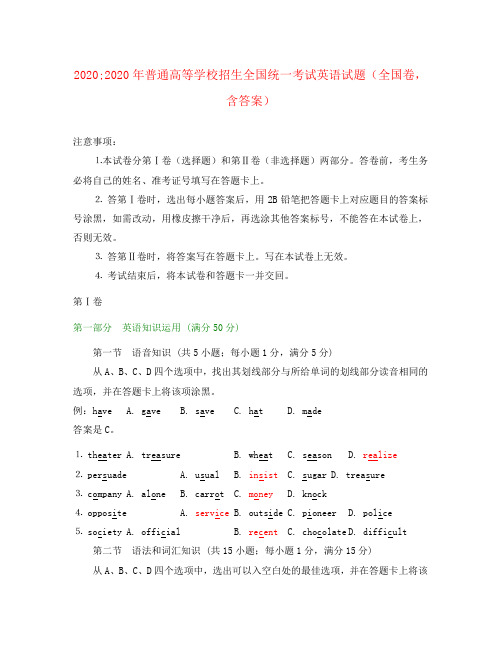
2020;2020年普通高等学校招生全国统一考试英语试题(全国卷,含答案)注意事项:⒈本试卷分第Ⅰ卷(选择题)和第Ⅱ卷(非选择题)两部分。
答卷前,考生务必将自己的姓名、准考证号填写在答题卡上。
⒉答第Ⅰ卷时,选出每小题答案后,用2B铅笔把答题卡上对应题目的答案标号涂黑,如需改动,用橡皮擦干净后,再选涂其他答案标号,不能答在本试卷上,否则无效。
⒊答第Ⅱ卷时,将答案写在答题卡上。
写在本试卷上无效。
⒋考试结束后,将本试卷和答题卡一并交回。
第Ⅰ卷第一部分英语知识运用 (满分50分)第一节语音知识 (共5小题;每小题1分,满分5分)从A、B、C、D四个选项中,找出其划线部分与所给单词的划线部分读音相同的选项,并在答题卡上将该项涂黑。
例:have A. gave B. save C. hat D. made答案是C。
⒈ th eater A. treasure B. wheat C. season D. realize⒉ persuade A. usual B. insist C. sugar D. treasure⒊ c ompany A. alone B. carrot C. money D. knock⒋ oppos ite A. service B. outside C. pioneer D. police⒌ society A. official B. recent C. chocolate D. difficult第二节语法和词汇知识 (共15小题;每小题1分,满分15分)从A、B、C、D四个选项中,选出可以入空白处的最佳选项,并在答题卡上将该项涂黑。
例:It is generally considered unwise to give a child ___ he or she wants.A. howeverB. whateverC. whicheverD. whenever答案是B。
⒍ – What shall we do tonight then?– ___ – whatever you want.A. Help yourselfB. It’s a dealC. No problemD.It’s up to you⒎ He missed ___ gold in the high jump, but will get ___ second chance inthe long jump.A. the; theB. 不填; aC. the; aD. a; 不填⒏ That evening, ___ I will tell you more about later, I ended up workingvery late.A. thatB. whichC. whatD. when⒐ Sarah made ___ to the airport just in time to catch her plane this morning.A. herselfB. thisC. thatD. it⒑ Tony lent me the money, ___ that I’d do as much for him.A. hopingB. to hopeC. hopedD. having hoped⒒ I had hardly got to the office ___ my wife phone me to go back home at once.A. whenB. thanC. untilD. after⒓ We ___ to paint the whole house but finished only the front part that day.A. set aboutB. set upC. set outD. set down⒔ Next to biology, I like physics ___ .A. betterB. bestC. the betterD. very well⒕– Did you ask Sophia for help?– I ___ need to – I managed perfectly well on my own.A. wouldn’tB. don’tC. didn’tD. won’t⒖ The old man sat in front of the television every evening, happy ___ anything that happened to be on.A. to watchB. watchingC. watchedD. to have watched⒗ 100℃ is the temperature ___ which water will boil.A. forB. atC. onD. of⒘ I’m going to Europe on vacation together with John if I ___ find the money.A. canB. mightC. wouldD. need⒙ The manager ___ the workers how to improve the program since 9 a.m. A. has told B. is telling C. has been telling D. will havetold⒚ The Harry Potter books are quite popular; they are in great ___ in this city.A. qualityB. progressC. productionD. demand⒛– Try not to work yourself too hard. Take it easy.– Thanks. ___A. So what?B. No way.C. What for?D. You, too.第三节完形填空 (每小题1. 5分)阅读下面短文,从短文后各题所给的四个选项 (A、B、C和D) 中,选出可以填入空白处的最佳选项,并在答题卡上将该项涂黑。
高中英语 2020年全国卷Ⅰ英语高考试题文档版(含答案)
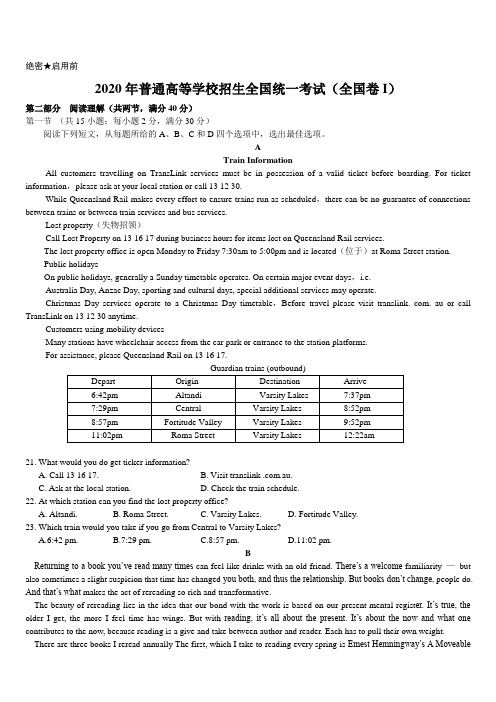
绝密★启用前2020年普通高等学校招生全国统一考试(全国卷I)第二部分阅读理解(共两节,满分40分)第一节(共15小题;每小题2分,满分30分)阅读下列短文,从每题所给的A、B、C和D四个选项中,选出最佳选项。
ATrain InformationAll customers travelling on TransLink services must be in possession of a valid ticket before boarding. For ticket information,please ask at your local station or call 13 12 30.While Queensland Rail makes every effort to ensure trains run as scheduled,there can be no guarantee of connections between trains or between train services and bus services.Lost property(失物招领)Call Lost Property on 13 16 17 during business hours for items lost on Queensland Rail services.The lost property office is open Monday to Friday 7:30am to 5:00pm and is located(位于)at Roma Street station.Public holidaysOn public holidays, generally a Sunday timetable operates. On certain major event days,i.e.Australia Day, Anzac Day, sporting and cultural days, special additional services may operate.Christmas Day services operate to a Christmas Day timetable,Before travel please visit translink. com. au or call TransLink on 13 12 30 anytime.Customers using mobility devicesMany stations have wheelchair access from the car park or entrance to the station platforms.For assistance, please Queensland Rail on 13 16 17.21. What would you do get ticker information?A. Call 13 16 17.B. Visit translink .com.au.C. Ask at the local station.D. Check the train schedule.22. At which station can you find the lost property office?A. Altandi.B. Roma Street.C. Varsity Lakes.D. Fortitude Valley.23. Which train would you take if you go from Central to Varsity Lakes?A.6:42 pm.B.7:29 pm.C.8:57 pm.D.11:02 pm.BReturning to a book you’ve read many times can feel like drinks with an old friend. There’s a welcome familiarity —but also sometimes a slight suspicion that time has changed you both, and thus the relationship. But books don’t change, people do. And that’s what makes the act of rereading so rich and transformative.The beauty of rereading lies in the idea that our bond with the work is based on our present mental regist er. It’s true, the older I get, the more I feel time has wings. But with reading, it’s all about the present. It’s about the now and what one contributes to the now, because reading is a give and take between author and reader. Each has to pull their own weight. There are three books I reread annually The first, which I take to reading every spring is Emest Hemningway’s A MoveableFeast. Published in 1964, it’s his classic memoir of 1920s Paris. The language is almost intoxicating (令人陶醉的),an aging writer looking back on an ambitious yet simpler time. Another is Annie Dillard’s Holy the Firm, her poetic 1975 ramble (随笔) about everything and nothing. The third book is Julio Cortazar’s Save Twilight: Selected Poems, because poetry. And because Cortazar.While I tend to buy a lot of books, these three were given to me as gifs, which might add to the meaning I attach to them. But I imagine that, while money is indeed wonderful and necessary, rereading an author’s work is the highest currency a reader can pay them. The best books are the ones that open further as time passes. But remember, it’s you that has to grow and read and reread in order to better understand your friends.24. Why does the author like rereading?A. It evaluates the writer-reader relationship.B. It’s a window to a whole new world.C. It’s a substitute for drinking with a friend.D. It extends the understanding of oneself.25. What do we know about the book A Moveable Feas!?A. It’s a brief account of a trip.B. It’s about Hemingway’s life as a young man.C. It’s a record of a historic event.D. It’s about Hemingway’s friends in Paris.26. What does the underlined word "currency"in paragraph 4 refer to?A. DebtB. Reward.C. Allowance.D. Face value.27. What can we infer about the author from the text?A. He loves poetry.B. He’s an editor.C. He’s very ambitious.D. He teaches reading.CRace walking shares many fitness benefits with running, research shows, while most likely contributing to fewer injuries. It does, however, have its own problem.Race walkers are conditioned athletes. The longest track and field event at the Summer Olympics is the 50-kilometer race walk, which is about five miles longer than the marathon. But the sport’s rules require that a race walker’s knees stay straight through most of the leg swing and one foot remain in contact (接触) with the ground at all times. It’s this strange form th at makes race walking such an attractive activity, however, says Jaclyn Norberg, an assistant professor of exercise science at Salem State University in Salem, Mass.Like running, race walking is physically demanding, she says, According to most calculations, race walkers moving at a pace of six miles per hour would burn about 800 calories(卡路里) per hour, which is approximately twice as many as they would burn walking, although fewer than running, which would probably burn about 1,000 or more calories per hour.However, race walking does not pound the body as much as running does, Dr. Norberg says. According to her research, runners hit the ground with as much as four times their body weight per step, while race walkers, who do not leave the ground, create only about 1.4 times their body weight with each step.As a result, she says, some of the injuries associated with running, suc h as runner’s knee, are uncommon among race walkers. But the sport’s strange form does place considerable stress on the ankles and hips, so people with a history of such injuries might want to be cautious in adopting the sport. In fact, anyone wishing to try race walking should probably first consult a coach or experienced racer to learn proper technique, she says. It takes some practice.28. Why are race walkers conditioned athletes?A. They must run long distances.B. They are qualified for the marathon.C. They have to follow special rules.D. They are good at swinging their legs.29. What advantage does race walking have over running?A. It’s more popular at the Olympics.B. It’s less challenging physically.C. It’s more effective in body building.D. It’s less likely to cause knee injuries.30 What is Dr. Norberg’s suggestion for someone trying race walking?A. Getting experts’ opinions.B. Having a medical checkup.C. Hiring an experienced coach.D. Doing regular exercises.31. Which word best describes the author’s attitude to race walking?A. Skeptical.B. Objective.C. Tolerant.D. Conservative.DThe connection between people and plants has long been the subject of scientific research. Recent studies have found positive effects. A study conducted in Youngstown,Ohio,for example, discovered that greener areas of the city experienced less crime. In another,employees were shown to be 15% more productive when their workplaces were decorated with houseplants.The engineers at the Massachusetts Institute of Technology(MIT)have taken it a step further changing the actual composition of plants in order to get them to perform diverse,even unusual functions. These include plants that have sensors printed onto their leaves to show when they’re shor t of water and a plant that can detect harmful chemicals in groundwater. "We’re thinking about how we can engineer plants to replace functions of the things that we use every day,"explained Michael Strano, a professor of chemical engineering at MIT.One of his latest projects has been to make plants grow(发光)in experiments using some common vegetables. Strano’s team found that they could create a faint light for three-and-a-half hours. The light,about one-thousandth of the amount needed to read by,is just a start. The technology, Strano said, could one day be used to light the rooms or even to turn tree into self-powered street lamps.in the future,the team hopes to develop a version of the technology that can be sprayed onto plant leaves in a one-off treat ment that would last the plant’s lifetime. The engineers are also trying to develop an on and off"switch"where the glow would fade when exposed to daylight.Lighting accounts for about 7% of the total electricity consumed in the US. Since lighting is often far removed from the power source(电源)—such as the distance from a power plant to street lamps on a remote highway-a lot of energy is lost during transmission(传输).Glowing plants could reduce this distance and therefore help save energy.32. What is the first paragraph mainly about?A. A new study of different plants.B. A big fall in crime rates.C. Employees from various workplaces.D. Benefits from green plants.33. What is the function of the sensors printed on plant leaves by MIT engineer?A. To detect plants’ lack of waterB. To change compositions of plantsC. To make the life of plants longer.D. To test chemicals in plants.34. What can we expect of the glowing plants in the future?A. They will speed up energy production.B. They may transmit electricity to the home.C. They might help reduce energy consumption.D. They could take the place of power plants.35. Which of the following can be the best title for the text?A. Can we grow more glowing plants?B. How do we live with glowing plants?C. Could glowing plants replace lamps?D. How are glowing plants made pollution-free?第二节(共5小题;每小题2分,满分10分)根据短文内容,从短文后的选项中选出能填入空白处的最佳选项。
2020年普通高等学校招生全国统一考试(全国卷I)-含答案

绝密★启用前2020年普通高等学校招生全国统一考试(全国卷I)英语注意事项:1. 答卷前,考生务必将自己的姓名、准考证号填写在答题卡和试卷指定位置上。
2. 回答选择题时,选出每小题答案后,用铅笔把答题卡上对应题目的答案标号涂黑。
如需改动,用橡皮擦干净后,再选涂其他答案标号。
回答非选择题时,将答案写在答题卡上,写在本试卷上无效。
3. 考试结束后,将本试卷和答题卡一并交回。
第一部分听力(共两节,满分30分)做题时,先将答案标在试卷上。
录音内容结束后,你将有两分钟的时间将试卷上的答案转涂到答题卡上。
第一节(共5小题;每小题1.5分,满分7.5分)听下面5段对话。
每段对话后有一个小题,从题中所给的A、B、C三个选项中选出最佳选项。
听完每段对话后,你都有10秒钟的时间来回答有关小题和阅读下一小题。
每段对话仅读一遍。
例:How much is the shirt?A. £19.15.B. £9.18.C. £9.15.答案是C。
1. Where are the speakers?A. At a swimming pool.B. In a clothing shop.C. At a school lab.2. What will Tom do next?A. Turn down the music.B. Postpone the show.C. Stop practicing.3. What is the woman busy doing?A. Working on a paper.B. Tidying up the office.C. Organizing a party.4. When will Henry start his vacation?A. This weekend.B. Next week.C. At the end of August.5. What does Donna offer to do for Bill?A. Book a flight for him.B. Drive him to the airport.C. Help him park the car.第二节(共15小题;每小题1.5分,满分22.5分)听下面5段对话或独白。
2020年普通高等学校招生全国统一考试英语试卷(全国I卷)(含答案)
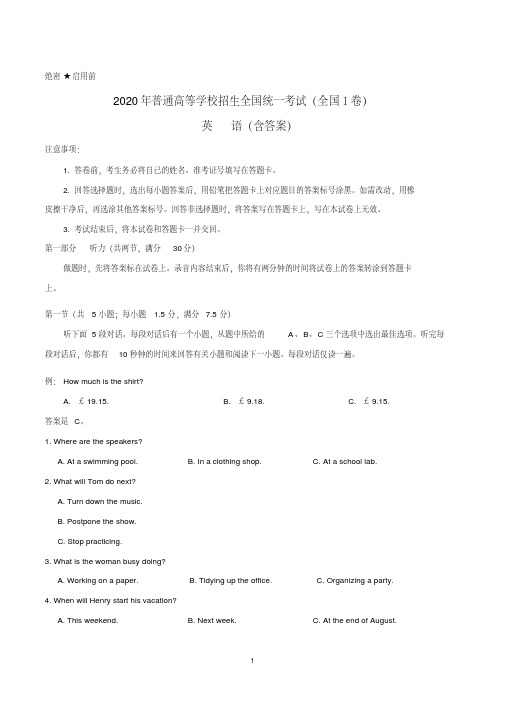
绝密★启用前2020年普通高等学校招生全国统一考试(全国Ⅰ卷)英语(含答案)注意事项:1. 答卷前,考生务必将自己的姓名、准考证号填写在答题卡。
2. 回答选择题时,选出每小题答案后,用铅笔把答题卡上对应题目的答案标号涂黑。
如需改动,用橡皮擦干净后,再选涂其他答案标号。
回答非选择题时,将答案写在答题卡上,写在本试卷上无效。
3. 考试结束后,将本试卷和答题卡一并交回。
第一部分听力(共两节,满分30分)做题时,先将答案标在试卷上。
录音内容结束后,你将有两分钟的时间将试卷上的答案转涂到答题卡上。
第一节(共5小题;每小题 1.5分,满分7.5分)听下面5段对话。
每段对话后有一个小题,从题中所给的A、B、C三个选项中选出最佳选项。
听完每段对话后,你都有10秒钟的时间来回答有关小题和阅读下一小题。
每段对话仅读一遍。
例:How much is the shirt?A. £19.15.B. £9.18.C. £9.15.答案是C。
1. Where are the speakers?A. At a swimming pool.B. In a clothing shop.C. At a school lab.2. What will Tom do next?A. Turn down the music.B. Postpone the show.C. Stop practicing.3. What is the woman busy doing?A. Working on a paper.B. Tidying up the office.C. Organizing a party.4. When will Henry start his vacation?A. This weekend.B. Next week.C. At the end of August.5. What does Donna offer to do for Bill?A. Book a flight for him.B. Drive him to the airport.C. Help him park the car.第二节(共15小题;每小题 1.5分,满分22.5分)听下面5段对话或独白。
2020年普通高等学校招生全国统一考试英语试题(全国卷1,参考版解析)
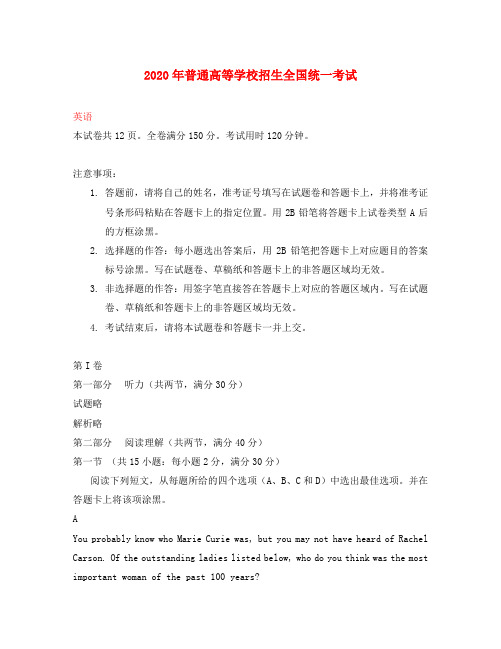
2020年普通高等学校招生全国统一考试英语本试卷共12页。
全卷满分150分。
考试用时120分钟。
注意事项:1.答题前,请将自己的姓名,准考证号填写在试题卷和答题卡上,并将准考证号条形码粘贴在答题卡上的指定位置。
用2B铅笔将答题卡上试卷类型A后的方框涂黑。
2.选择题的作答:每小题选出答案后,用2B铅笔把答题卡上对应题目的答案标号涂黑。
写在试题卷、草稿纸和答题卡上的非答题区域均无效。
3.非选择题的作答:用签字笔直接答在答题卡上对应的答题区域内。
写在试题卷、草稿纸和答题卡上的非答题区域均无效。
4.考试结束后,请将本试题卷和答题卡一并上交。
第I卷第一部分听力(共两节,满分30分)试题略解析略第二部分阅读理解(共两节,满分40分)第一节(共15小题:每小题2分,满分30分)阅读下列短文,从每题所给的四个选项(A、B、C和D)中选出最佳选项。
并在答题卡上将该项涂黑。
AYou probably know who Marie Curie was, but you may not have heard of Rachel Carson. Of the outstanding ladies listed below, who do you think was the most important woman of the past 100 years?Jane Addams (1860-1935)Anyone who has ever been helped by a social worker has Jane Addams to thank. Addams helped the poor and worked for peace. She encouraged a sense of community (社区) by creating shelters and promoting education and services for people in need. In 1931, Addams became the first American woman to win the Nobel Peace Prize.Rachel Carson (1907-1964)If it weren’t for Rachel Carson, the environment al movement might not exist today. Her popular 1962 book Silent Spring raised awareness of the dangers of pollution and the harmful effects of chemicals on humans and on the world’s lakes and oceans.Sandra Day O’Connor (1930-present)When Sandra Day O’Connor finished third in her class at Stanford Law School, in 1952, she could not find work at a law firm because she was a woman. She became an Arizona state senator (参议员) and, in 1981, the first woman to join the U.S. Supreme Court. O’Connor gave the deciding vote in many important cases during her 24 years on the top court.Rosa Parks (1913-2020)On December 1. 1995, in Montgomery, Alabama, Rosa Parks would not give up her seat on a bus to a white passenger. Her simple act landed Parks in prison. But it also set off the Montgomery bus boycott. It lasted for more than a year, and kicked off the civil-rights movement. “The only tired I was, was tired of giving in,” said Parks.21. What is Jane Addams noted for in history?A. Her social work.B. Her teaching skills.C. Her efforts to win a prize.D. Her community background.22. What was the reason for O’Connor’s being rejected by the law firm?A. Her lack of proper training in law.B. Her little work experience in court.C. The discrimination against women.D. The poor financial conditions.23. Who made a great contribution to the civil-rights movement in the U.S.?A. Jane Addams.B. Rachel Carson.C. Sandra Day O’C onnorD. Rosa Parks.24. What can we infer about the women mentioned in the text?A. They are highly educated.B. They are truly creative.C. They are pioneers.D. They are peace-lovers.21.【解析】A信息概括题。
2020年普通高等学校招生全国统一考试英语试题(新课标I,含答案)
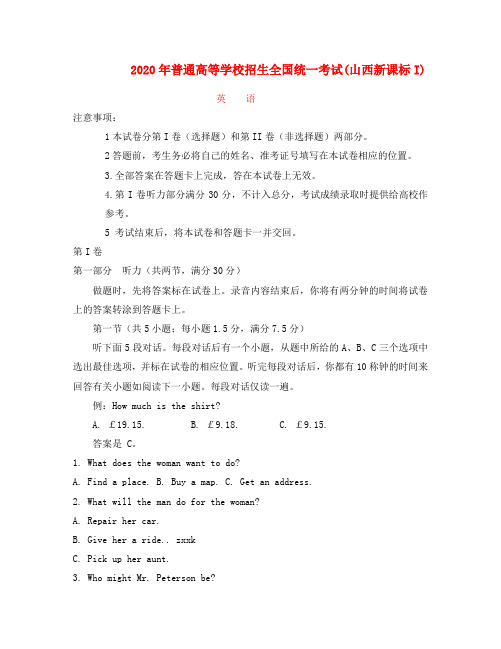
2020年普通高等学校招生全国统一考试(山西新课标I)英语注意事项:1本试卷分第I卷(选择题)和第II卷(非选择题)两部分。
2答题前,考生务必将自己的姓名、准考证号填写在本试卷相应的位置。
3.全部答案在答题卡上完成,答在本试卷上无效。
4.第I卷听力部分满分30分,不计入总分,考试成绩录取时提供给高校作参考。
5 考试结束后,将本试卷和答题卡一并交回。
第I卷第一部分听力(共两节,满分30分)做题时,先将答案标在试卷上。
录音内容结束后,你将有两分钟的时间将试卷上的答案转涂到答题卡上。
第一节(共5小题;每小题1.5分,满分7.5分)听下面5段对话。
每段对话后有一个小题,从题中所给的A、B、C三个选项中选出最佳选项,并标在试卷的相应位置。
听完每段对话后,你都有10称钟的时间来回答有关小题如阅读下一小题。
每段对话仅读一遍。
例:How much is the shirt?A. £19.15.B. £9.18.C. £9.15.答案是 C。
1. What does the woman want to do?A. Find a place.B. Buy a map.C. Get an address.2. What will the man do for the woman?A. Repair her car.B. Give her a ride.. zxxkC. Pick up her aunt.3. Who might Mr. Peterson be?A. A new professor.B. A department head.C. A company director.4. What does the man think of the book?A. Quite difficult..B. Very interesting.C. Too simple.5. What are the speakers talking about?A. Weather.B. Clothes.C. News.第二节(共15小题;每小题1.5分,满分22.5分)听下面5段对话或独白。
2020年全国普通高等学校招生统一考试英语试卷 全国新高考Ⅰ卷 (含答案)

2020年全国普通高等学校招生统一考试试卷全国新高考Ⅰ卷英语注意事项:1. 答卷前, 考生务必将自己的姓名、准考证号填写在答题卡上。
2. 回答选择题时, 选出每小题答案后, 用铅笔把答题卡上对应题目的答案标号涂黑。
如需改动, 用橡皮擦干净后, 再选涂其他答案标号。
回答非选择题时, 将答案写在答题卡上, 写在本试卷上无效。
3. 考试结束后, 将本试卷和答题卡一并交回。
第一部分阅读(共两节, 满分50分)第一节(共15小题:每小题2.5分, 满分37.5分)阅读下列短文, 从每题所给的A、B、C、D四个选项中选出最佳选项。
APOETRY CHALLENGEWrite a poem about how courage, determination, and strength have helped you face challenges in your life.Prizes3 Grand Prizes:Trip to Washington, D.C. for each of three winners, a parent and one other person of the winner's choice. Trip includes round-trip air tickets, hotel stay for two nights, and tours of the National Air and Space Museum and the office of National Geographic World.6 First Prizes:The book Sky Pioneer:A Photobiography of Amelia Earhart signed by author Corinne Szabo and pilot Linda Finch.50 Honorable Mentions:Judges will choose up to 50 honorable mention winners, who will each receive a T-shirt in memory of Earhart's final flight.RulesFollow all rules carefully to prevent disqualification.■Write a poem using 100 words or fewer. Your poem can be any format, any number of lines.■Write by hand or type on a single sheet of paper. You may use both the front and back of the paper.■On the same sheet of paper, write or type your name, address, telephone number, and birth date.■Mail your entry to us by October 31 this year.1. How many people can each grand prize winner take on the free trip? ()A. Two.B. Three.C. Four.D. Six.2. What will each of the honorable mention winners get? ()A. A plane ticket.B. A book by Corinne Szabo.C. A special T-shirt.D. A photo of Amelia Earhart.3. Which of the following will result in disqualification? ()A. Typing your poem out.B. Writing a poem of 120 words.C. Using both sides of the paper.D. Mailing your entry on October 30.BJenifer Mauer has needed more willpower than the typical college student to pursue her goal of earning a nursing degree. That willpower bore fruit when Jennifer graduated from University of Wisconsin-Eau Claire and became the first in her large family to earn a bachelor's degree.Mauer, of Edgar, Wisconsin, grew up on a farm in a family of 10 children. Her dad worked at a job away from the farm, and her mother ran the farm with the kids. After high school, Jennifer attended a local technical college, working to pay her tuition(学费), because there was no extra money set aside for a college education. After graduation, she worked to help her sisters and brothers pay for their schooling.Jennifer now is married and has three children of her own. She decided to go back to college to advance her career and to be able to better support her family while doing something she loves: nursing. She chose the UW-Eau Claire program at Ministry Saint Joseph's Hospital in Marshfield because she was able to pursue her four-year degree close to home. She could drive to class and be home in the evening to help with her kids. Jenifer received great support from her family as she worked to car her degree: Her husband worked two jobs to cover the bills, and her 68-year-old mother helped take care of the children at times.Through it all, she remained in good academic standing and graduated with honors. Jennifer sacrificed(牺牲)to achieve her goal, giving up many nights with her kids and missing important events to study. “Some nights my heart was breaking to have to pick betw een my kids and studying for exams or papers,” she says. However, her children have learned an important lesson witnessing their mother earn her degree. Jennifer is a first-generation graduate and an inspirationto her family-and that's pretty powerful.4. What did Jennifer do after high school? ()A. She helped her dad with his work.B. She ran the family farm on her own.C. She supported herself through college.D. She taught her sisters and brothers at home.5. Why did Jennifer choose the program at Ministry Saint Joseph's Hospital in Marshfield? ()A. To take care of her kids easily.B. To learn from the best nurses.C. To save money for her parents.D. To find a well-paid job there.6. What did Jennifer sacrifice to achieve her goal? ()A. Her health.B. Her time with family.C. Her reputation.D. Her chance of promotion.7. What can we learn from Jenifer's story? ()A. Time is money.B. Love breaks down barriers.C. Hard work pays off.D. Education is the key to success.CIn the mid-1990s, Tom Bissell taught English as a volunteer in Uzbekistan. He left after seven months, physically broken and having lost his mind. A few years later, still attracted to the country, he returned to Uzbekistan to write an article about the disappearance of the Aral Sea.His visit, however, ended up involving a lot more than that. Hence this book, Chasing the Sea: Lost Among the Ghosts of Empire in Central Asia, which talks about a road trip from Tashkent to Karakalpakstan, where millions of lives have been destroyed by the slow drying up of the sea. It is the story of an American travelling to a strange land, and of the people he meets on his way: Rustam, his translator, a lovely 24-year-old who picked up his colorful English in California, Oleg and Natasha, his hosts in Tashkent, and a string of foreign aid workers.This is a quick look at life in Uzbekistan, made of friendliness and warmth, but also its darker side of society. In Samarkand, Mr Bissell admires the architectural wonders, while on his way to Bukhara he gets a taste of police methods when suspected of drug dealing. In Ferghana, he attends a mountain funeral(葬礼)followed by a strange drinking party. And in Karakalpakstan, he issaddened by the dust storms, diseases and fishing boats stuck miles from the sea.Mr Bissell skillfully organizes historical insights and cultural references, making his tale a well-rounded picture of Uzbekistan, seen from Western eyes. His judgment and references are decidedly American, as well as his delicate stomach. As the author explains, this is neither a travel nor a history book, or even a piece of reportage. Whatever it is, the result is a fine and vivid description of the purest of Central Asian traditions.8. What made Mr Bissell return to Uzbekistan? ()A. His friends' invitation.B. His interest in the country.C. His love for teaching.D. His desire to regain health.9. What does the underlined word “that” in paragraph 2 refer to? ()A. Developing a serious mental disease.B. Taking a guided tour in Central Asia.C. Working as a volunteer in Uzbekistan.D. Writing an article about the Aral Sea.10. Which of the following best describes Mr Bissell's road trip in Uzbekistan? ()A. Romantic.B. Eventful.C. Pleasant.D. Dangerous.11. What is the purpose of this text? ()A. To introduce a book.B. To explain a cultural phenomenon.C. To remember a writer.D. To recommend a travel destination.DAccording to a recent study in the Journal of Consumer Research, both the size and consumption habits of our eating companions can influence our food intake. And contrary to existing research that says you should avoid eating with heavier people who order large portions (份), it's the beanpoles with big appetites you really need to avoid.To test the effect of social influence on eating habits, the researchers conducted two experiments. In the first, 95 undergraduate women were individually invited into a lab to ostensibly(表面上)participate in a study about movie viewership. Before the film began, each woman was asked to help herself to a snack. An actor hired by the researchers grabbed her food first. In her natural state, the actor weighed 105 pounds. But in half the cases she wore a specially designed fat suit which increased her weight to 180 pounds.Both the fat and thin versions of the actor took a large amount of food. The participants followed suit, taking more food than they normally would have. However, they took significantly more when the actor was thin.For the second test, in one case the thin actor took two pieces of candy from the snack bowls. In the other case, she took 30 pieces. The results were similar to the first test: the participants followed suit but took significantly more candy when the thin actor took 30 pieces.The tests show that the social environment is extremely influential when we're making decisions. If this fellow participant is going to eat more, so will I. Call it the “I’ll have what she's having” effe ct. However, we'll adjust the influence. If an overweight person is having a large portion, I'll hold back a bit because I see the results of his eating habits. But if a thin person eats a lot, I'll follow suit. If he can eat much and keep slim, why can't I?12. What is the recent study mainly about? ()A. Food safety.B. Movie viewership.C. Consumer demand.D. Eating behavior.13. What does the underlined word "beanpoles" in paragraph 1 refer to? ()A. Big eaters.B. Overweight persons.C. Picky eaters.D. Tall thin persons.14. Why did the researchers hire the actor? ()A. To see how she would affect the participants.B. To test if the participants could recognize her.C. To find out what she would do in the two tests.D. To study why she could keep her weight down.15. On what basis do we "adjust the influence" according to the last paragraph? ()A. How hungry we are.B. How slim we want to be.C. How we perceive others.D. How we feel about the food.第二节(共5小题:每小题2. 5分, 满分12. 5分)阅读下面短文, 从短文后的选项中选出可以填入空白处的最佳选项。
2020年普通高等学校招生全国统一考试英语试题(课标全国卷Ⅰ,解析版)

2020;2020年普通高等学校招生全国统一考试英语试题(课标全国卷Ⅰ,解析版)第一部分听力1.B2.B3.A4.B5.C6.A7.C8.A9.A 10.B 11.C 12.A 13.C 14.C 15.B 16.B 17.C 18.B 19.C 20.A第二部分英语知识运用第一节单项填空21.A.解析:时态考查题。
由第二句答语中的时间状语all day yesterday 表明,“昨天一整天都在做作业”,用过去进行时,选A。
22.D.解析:考查动词词义区别。
A项carried“ (用手、肩等)挑,抱,背,提,扛,搬;运送,运载;搬运”;B项delivered“投递,递送”;C项pressed“按压”;D 项packed“打包”。
由句中并列的谓语…and marked on each box…中marked表明“在做打包与标识”,选D。
23.B.解析:考查代词词义区别题。
由句中half表明假期被分成两半,表示“两个中的另一个”要用the other,选B。
24.A.解析:非限制性定语从句题。
由逗号及语义表明,后句所指“村校”是以其祖父命名的,是非限制性定语从句,选A。
25.C.解析:考查状语从句题。
A项so that“因此”;B项although“尽管”;C项while“当……的时候”;D项as if“好像”。
由从句中“当客人正在吃饭的时候,Mary在泡咖啡”可知,表示“当……的时候”要用while,选C。
26.A.解析:考查形容词副词比较级结构。
由句中as表明是同级相比,用as/so,再由句中seldom表明是否定,所以用so。
27.C.解析:非谓语动词考查题。
由句意“Mrs. White给学生看从图书馆借来的旧地图”表明,地图与借borrow是动宾关系,宾语在前动词在后,表被动用过去分词。
选C。
28.B.解析:动词时态题。
由句意“当你到家后,给我打个电话让我知道你已经安全到家了”可知,要用现在完成时。
2020年全国普通高等学校招生统一考试英语试卷 全国Ⅰ卷(含答案)

绝密★启用前2020年普通高等学校招生全国统一考试(全国卷I)英语注意事项:1. 答卷前,考生务必将自己的姓名、准考证号填写在答题卡和试卷指定位置上。
2. 回答选择题时,选出每小题答案后,用铅笔把答题卡上对应题目的答案标号涂黑。
如需改动,用橡皮擦干净后,再选涂其他答案标号。
回答非选择题时,将答案写在答题卡上,写在本试卷上无效。
3. 考试结束后,将本试卷和答题卡一并交回。
第一部分听力(共两节,满分30分)做题时,先将答案标在试卷上。
录音内容结束后,你将有两分钟的时间将试卷上的答案转涂到答题卡上。
第一节(共5小题;每小题1.5分,满分7.5分)听下面5段对话。
每段对话后有一个小题,从题中所给的A、B、C三个选项中选出最佳选项。
听完每段对话后,你都有10秒钟的时间来回答有关小题和阅读下一小题。
每段对话仅读一遍。
例:How much is the shirt?A. £19.15.B. £9.18.C. £9.15.答案是C。
1. Where are the speakers?A. At a swimming pool.B. In a clothing shop.C. At aschool lab.2. What will Tom do next?A. Turn down the music.B. Postpone the show.C.Stop practicing.3. What is the woman busy doing?A. Working on a paper.B. Tidying up the office.C. Organizing a party.4. When will Henry start his vacation?A. This weekend.B. Next week.C. At theend of August.5. What does Donna offer to do for Bill?A. Book a flight for him.B. Drive him to the airport.C. Help him park the car.第二节(共15小题;每小题1.5分,满分22.5分)听下面5段对话或独白。
2020年全国普通高等学校招生统一考试英语试卷 全国新高考Ⅰ卷 (含答案)

2020年全国普通高等学校招生统一考试试卷全国新高考Ⅰ卷英语注意事项:1. 答卷前, 考生务必将自己的姓名、准考证号填写在答题卡上。
2. 回答选择题时, 选出每小题答案后, 用铅笔把答题卡上对应题目的答案标号涂黑。
如需改动, 用橡皮擦干净后, 再选涂其他答案标号。
回答非选择题时, 将答案写在答题卡上, 写在本试卷上无效。
3. 考试结束后, 将本试卷和答题卡一并交回。
第一部分阅读(共两节, 满分50分)第一节(共15小题:每小题2.5分, 满分37.5分)阅读下列短文, 从每题所给的A、B、C、D四个选项中选出最佳选项。
APOETRY CHALLENGEWrite a poem about how courage, determination, and strength have helped you face challenges in your life.Prizes3 Grand Prizes:Trip to Washington, D.C. for each of three winners, a parent and one other person of the winner's choice. Trip includes round-trip air tickets, hotel stay for two nights, and tours of the National Air and Space Museum and the office of National Geographic World.6 First Prizes:The book Sky Pioneer:A Photobiography of Amelia Earhart signed by author Corinne Szabo and pilot Linda Finch.50 Honorable Mentions:Judges will choose up to 50 honorable mention winners, who will each receive a T-shirt in memory of Earhart's final flight.RulesFollow all rules carefully to prevent disqualification.■Write a poem using 100 words or fewer. Your poem can be any format, any number of lines.■Write by hand or type on a single sheet of paper. You may use both the front and back of the paper.■On the same sheet of paper, write or type your name, address, telephone number, and birthdate.■Mail your entry to us by October 31 this year.1. How many people can each grand prize winner take on the free trip? ()A. Two.B. Three.C. Four.D. Six.2. What will each of the honorable mention winners get? ()A. A plane ticket.B. A book by Corinne Szabo.C. A special T-shirt.D. A photo of Amelia Earhart.3. Which of the following will result in disqualification? ()A. Typing your poem out.B. Writing a poem of 120 words.C. Using both sides of the paper.D. Mailing your entry on October 30.BJenifer Mauer has needed more willpower than the typical college student to pursue her goal of earning a nursing degree. That willpower bore fruit when Jennifer graduated from University of Wisconsin-Eau Claire and became the first in her large family to earn a bachelor's degree.Mauer, of Edgar, Wisconsin, grew up on a farm in a family of 10 children. Her dad worked at a job away from the farm, and her mother ran the farm with the kids. After high school, Jennifer attended a local technical college, working to pay her tuition(学费), because there was no extra money set aside for a college education. After graduation, she worked to help her sisters and brothers pay for their schooling.Jennifer now is married and has three children of her own. She decided to go back to college to advance her career and to be able to better support her family while doing something she loves: nursing. She chose the UW-Eau Claire program at Ministry Saint Joseph's Hospital in Marshfield because she was able to pursue her four-year degree close to home. She could drive to class and be home in the evening to help with her kids. Jenifer received great support from her family as she worked to car her degree: Her husband worked two jobs to cover the bills, and her 68-year-old mother helped take care of the children at times.Through it all, she remained in good academic standing and graduated with honors. Jennifer sacrificed(牺牲)to achieve her goal, giving up many nights with her kids and missing important events to study. “Some nights my heart was breaking to have to pick between my kids and studying for exams or papers,” she says. However, her children have learned an important lessonwitnessing their mother earn her degree. Jennifer is a first-generation graduate and an inspiration to her family-and that's pretty powerful.4. What did Jennifer do after high school? ()A. She helped her dad with his work.B. She ran the family farm on her own.C. She supported herself through college.D. She taught her sisters and brothers at home.5. Why did Jennifer choose the program at Ministry Saint Joseph's Hospital in Marshfield? ()A. To take care of her kids easily.B. To learn from the best nurses.C. To save money for her parents.D. To find a well-paid job there.6. What did Jennifer sacrifice to achieve her goal? ()A. Her health.B. Her time with family.C. Her reputation.D. Her chance of promotion.7. What can we learn from Jenifer's story? ()A. Time is money.B. Love breaks down barriers.C. Hard work pays off.D. Education is the key to success.CIn the mid-1990s, Tom Bissell taught English as a volunteer in Uzbekistan. He left after seven months, physically broken and having lost his mind. A few years later, still attracted to the country, he returned to Uzbekistan to write an article about the disappearance of the Aral Sea.His visit, however, ended up involving a lot more than that. Hence this book, Chasing the Sea: Lost Among the Ghosts of Empire in Central Asia, which talks about a road trip from Tashkent to Karakalpakstan, where millions of lives have been destroyed by the slow drying up of the sea. It is the story of an American travelling to a strange land, and of the people he meets on his way: Rustam, his translator, a lovely 24-year-old who picked up his colorful English in California, Oleg and Natasha, his hosts in Tashkent, and a string of foreign aid workers.This is a quick look at life in Uzbekistan, made of friendliness and warmth, but also its darker side of society. In Samarkand, Mr Bissell admires the architectural wonders, while on his way to Bukhara he gets a taste of police methods when suspected of drug dealing. In Ferghana, he attendsa mountain funeral(葬礼)followed by a strange drinking party. And in Karakalpakstan, he is saddened by the dust storms, diseases and fishing boats stuck miles from the sea.Mr Bissell skillfully organizes historical insights and cultural references, making his tale a well-rounded picture of Uzbekistan, seen from Western eyes. His judgment and references are decidedly American, as well as his delicate stomach. As the author explains, this is neither a travel nor a history book, or even a piece of reportage. Whatever it is, the result is a fine and vivid description of the purest of Central Asian traditions.8. What made Mr Bissell return to Uzbekistan? ()A. His friends' invitation.B. His interest in the country.C. His love for teaching.D. His desire to regain health.9. What does the underlined word “that” in paragraph 2 refer to? ()A. Developing a serious mental disease.B. Taking a guided tour in Central Asia.C. Working as a volunteer in Uzbekistan.D. Writing an article about the Aral Sea.10. Which of the following best describes Mr Bissell's road trip in Uzbekistan? ()A. Romantic.B. Eventful.C. Pleasant.D. Dangerous.11. What is the purpose of this text? ()A. To introduce a book.B. To explain a cultural phenomenon.C. To remember a writer.D. To recommend a travel destination.DAccording to a recent study in the Journal of Consumer Research, both the size and consumption habits of our eating companions can influence our food intake. And contrary to existing research that says you should avoid eating with heavier people who order large portions (份), it's the beanpoles with big appetites you really need to avoid.To test the effect of social influence on eating habits, the researchers conducted two experiments. In the first, 95 undergraduate women were individually invited into a lab to ostensibly(表面上)participate in a study about movie viewership. Before the film began, each woman was asked to help herself to a snack. An actor hired by the researchers grabbed her food first. In her natural state, the actor weighed 105 pounds. But in half the cases she wore a speciallydesigned fat suit which increased her weight to 180 pounds.Both the fat and thin versions of the actor took a large amount of food. The participants followed suit, taking more food than they normally would have. However, they took significantly more when the actor was thin.For the second test, in one case the thin actor took two pieces of candy from the snack bowls. In the other case, she took 30 pieces. The results were similar to the first test: the participants followed suit but took significantly more candy when the thin actor took 30 pieces.The tests show that the social environment is extremely influential when we're making decisions. If this fellow participant is going to eat more, so will I. Call it the “I’ll have what she's having” effect. However, we'll adjust the influence. If an overweight person is having a large portion, I'll hold back a bit because I see the results of his eating habits. But if a thin person eats a lot, I'll follow suit. If he can eat much and keep slim, why can't I?12. What is the recent study mainly about? ()A. Food safety.B. Movie viewership.C. Consumer demand.D. Eating behavior.13. What does the underlined word "beanpoles" in paragraph 1 refer to? ()A. Big eaters.B. Overweight persons.C. Picky eaters.D. Tall thin persons.14. Why did the researchers hire the actor? ()A. To see how she would affect the participants.B. To test if the participants could recognize her.C. To find out what she would do in the two tests.D. To study why she could keep her weight down.15. On what basis do we "adjust the influence" according to the last paragraph? ()A. How hungry we are.B. How slim we want to be.C. How we perceive others.D. How we feel about the food.第二节(共5小题:每小题2. 5分, 满分12. 5分)阅读下面短文, 从短文后的选项中选出可以填入空白处的最佳选项。
2020年高考英语试卷全国卷I(新课标Ⅰ)(word解析版)
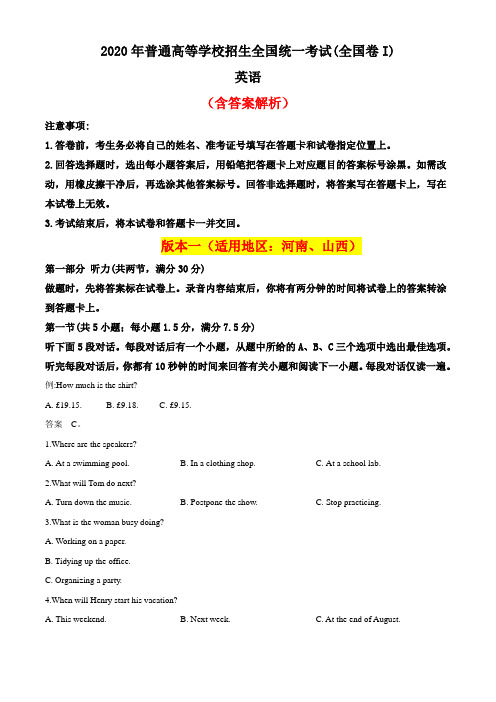
A. A restaurant.
B. A laundry.
C. A grocery store.
15. Which is included in the rent?
A. Electricity.
B. The Internet.
听下面一段较长对话,回答以下小题。
11 How did the man feel about his performance today?
A. Greatly encouraged.
B. A bit dissatisfied.
C. Terat did the man say helped him overcome the problem?
A. Forgiving.B. Sympathetic.C. Supportive.
10. What might Cathy do for the present company?
A. Apply for a project.B. Train a new person.C. Recommend an engineer.
C. Satellite TV.
16. What does the woman think of the apartment?
A. It’s quite large.
B. It’s well furnished.
C. It’s worth the money.
听下面一段独白,回答以下小题
17. Where is Jeff from?
A. Turn down the music.B. Postpone the show.C. Stop practicing.
- 1、下载文档前请自行甄别文档内容的完整性,平台不提供额外的编辑、内容补充、找答案等附加服务。
- 2、"仅部分预览"的文档,不可在线预览部分如存在完整性等问题,可反馈申请退款(可完整预览的文档不适用该条件!)。
- 3、如文档侵犯您的权益,请联系客服反馈,我们会尽快为您处理(人工客服工作时间:9:00-18:30)。
2020年普通高等学校招生全国统一考试(全国卷I)英语注意事项:1. 答卷前,考生务必将自己的姓名、准考证号填写在答题卡和试卷指定位置上。
2. 回答选择题时,选出每小题答案后,用铅笔把答题卡上对应题目的答案标号涂黑。
如需改动,用橡皮擦干净后,再选涂其他答案标号。
回答非选择题时,将答案写在答题卡上,写在本试卷上无效。
3. 考试结束后,将本试卷和答题卡一并交回。
第一部分听力(共两节,满分30分)做题时,先将答案标在试卷上。
录音内容结束后,你将有两分钟的时间将试卷上的答案转涂到答题卡上。
略……略……略……第二部分阅读理解(共两节,满分40分)第一节(共15小题;每小题2分,满分30分)阅读下列短文,从每题所给的A、B、C和D四个选项中,选出最佳选项。
ATrain InformationAll customers travelling on TransLink services must be in possession of a valid ticket before boarding.For ticket information,please ask at your local station or call 13 12 30.While Queensland Rail makes every effort to ensure trains run as scheduled,there can be no guarantee of connections between trains or between train services and bus services.Lost property(失物招领)Call Lost Property on 13 16 17 during business hours for items lost on Queensland Rail services.The lost property office is open Monday to Friday 7:30am to 5:00pm and is located(位于)at Roma Street station.Public holidaysOn public holidays,generally a Sunday timetable operates.On certain major event days,i.e.Australia Day, Anzac Day,sporting and cultural days, special additional services may operate.Christmas Day services operate to a Christmas Day timetable,Before travel please visit .au or call TransLink on 13 12 30 anytime.Customers using mobility devicesMany stations have wheelchair access from the car park or entrance to the station platforms.For assistance,please Queensland Rail on 13 16 17.Guardian trains (outbound)21. What would you do get ticker information?A.Call 13 16 17B. Visit translink .com.au.C. Ask at the local station.D. Check the train schedule.【分值】2分【答案】C22. At which station can you find the lost property office?A.Altandi.B.Roma Street.C.Varsity LakesD. Fortitude Valley.【分值】2分【答案】B23. Which train would you take if you go from Central to Varsity Lakes?A.6:42pmB.7:29pmC.8:57pm.D.11:02pm.【分值】2分【答案】BBReturning to a book you’ve read many times can feel like drinks with an old friend.There’s a welcomefamiliar ity — but also sometimes a slight suspicion that time has changedyou both, and thus the relationship. But books don’t change,people do.And that’s whatmakes the act of rereading so rich and transformative.The beauty of rereading lies in the idea that our bond with the work is based on ourpresent mental register. It’s true, the older I get, the more I feel time has wings. But withreading, it’s all about the present. It’s about the now and what one contributes to the now,because reading is a give and take between author and reader. Each has to pull their ownweight.There are three books I reread annually The first, which I take to reading every spring isEmest Hemningway’s A Moveable Feast. Published in 1964, it’s his classic memoir of 1920s Paris.The language is almost intoxicating (令人陶醉的),an aging writer looking back on an ambitiousyet simpler time. Another is Annie Dillard’s Holy the Firm, her poetic 1975 ramble (随笔)about everything and nothing. The third book is Julio Cortazar’s Save Twilight: SelectedPoems, because poetry. And because Cortazar.While I tend to buy a lot of books, these three were given to me as gifs, which mightadd to the meaning I attach to them. But I imagine that, while money is indeed wonderful andnecessary, rereading an author’s work is the highest currency a reader can pay them. The bestbooks are the ones that open further as time passes. But remember, it’s you that has to growand read and reread in order to better understand your friends.24. Why does the author like rereading?A.It evaluates the writer-reader relationship.B.It’s a window to a whole new world.C.It’s a substitute for drinking with a friend.D. It extends the understanding of oneself.【分值】2分【答案】D25. What do we know about the book A Moveable Feas!?A. It’s a brief account of a trip.B. It’s about Hemingway’s life as a young man.C. It’s a record of a historic event.D. It’s about Hemingway’s friends in Paris.【分值】2分【答案】B26. What does the underlined word"currency" in paragraph 4 refer to?A. DebtB. Reward.C. Allowance.D. Face value.【分值】2分【答案】B27. What can we infer about the author from the text?A. He loves poetry.B. He’s an editor.C. He’s very ambitious.D. He teaches reading.【分值】2分【答案】ACRace walking shares many fitness benefits with running, research shows, while most likely contributing to fewer injuries. It does, however, have its own problem.Race walkers are conditioned athletes. The longest track and field event at the Summer Olympics is the 50-kilometer race walk, which is about five miles longer than the marathon. But the sport’s rules require that a race walker’s knees stay straight through most of the leg swing and one foot remain in contact (接触) with the ground at all times. It’s this strange form that makes race walking such an attractive activity, however, says Jaclyn Norberg, an assistant professor of exercise science at Salem State University in Salem, Mass.Like running, race walking is physically demanding, she says, According to most calculations, race walkers moving at a pace of six miles per hour would burn about 800 calories(卡路里) per hour, which is approximately twice as many as they would burn walking, although fewer than running, which would probably burn about 1,000 or more calories per hour.However, race walking does not pound the body as much as running does, Dr. Norberg says. According to her research, runners hit the ground with as much as four times their body weight per step, while race walkers, who do not leave the ground, create only about 1.4 times their body weight with each step.As a result, she says, some of the injuries associated with running, such as runner’s knee, are uncommon among race walkers. But the sport’s strange form does place considerable stress on the ankles and hips, so people with a history of such injuries might want to be cautious in adopting the sport. In fact, anyone wishing to try race walking should probably first consult a coach or experienced racer tolearn proper technique, she says. It takes some practice.28. Why are race walkers conditioned athletes?A. They must run long distances.B. They are qualified for the marathon.C. They have to follow special rules.D. They are good at swinging their legs.【分值】2分【答案】C29. What advantage does race walking have over running?A. It’s more popular at the Olympics.B. It’s less challenging physically.C. It’s more effective in body building.D. It’s less likely to cause knee injuries.【分值】2分【答案】D30 What is Dr. Norberg’s suggestion for someone trying race walking?A. Getting experts’ opinions.B. Having a medical checkup.C. Hiring an experienced coach.D. Doing regular exercises.【分值】2分【答案】A31.Which word best describes the author’s attitude to race walking?A. Skeptical.B. Objective.C. TolerantD. Conservative.【分值】2分【答案】BDThe connection between people and plants has long been the subject of scientific research.Recent studies have found positive effects. A study conducted in Youngstown,Ohio,for example, discovered that greener areas of the city experienced less crime. In another,employees were shown to be 15% more productive when their workplaces were decorated with houseplants.The engineers at the Massachusetts Institute of Technology(MIT)have taken it a step further changing the actual composition of plants in order to get them to perform diverse,even unusual functions. These include plants that have sensors printed onto th eir leaves to show when they’re short of water and a plant that can detect harmful chemicals in groundwater. "We’re thinking about how we can engineer plants to replace functions of the things that we use every day,"explained Michael Strano, a professor of chemical engineering at MIT.One of his latest projects has been to make plants grow(发光)in experiments using some common vegetables. Strano’s team found that they could create a faint light for three-and-a-half hours. The light,about one-thousandth of the amount needed to read by,is just a start. The technology, Strano said, could one day be used to light the rooms or even to turn tree into self-powered street lamps.in the future,the team hopes to develop a version of the technology that can be sprayed onto plant leaves in a one-off treatment that would last the plant’s lifetime. The engineers are also trying to develop an on and off"switch"where the glow would fade when exposed to daylight.Lighting accounts for about 7% of the total electricity consumed in the US. Since lighting is often far removed from the power source(电源)—such as the distance from a power plant to street lamps on a remote highway-a lot of energy is lost during transmission(传输).Glowing plants could reduce this distance and therefore help save energy.32. What is the first paragraph mainly about?A. A new study of different plants.B. A big fall in crime rates.C. Employees from various workplaces.D. Benefits from green plants.【分值】2分【答案】D33. What is the function of the sensors printed on plant leaves by MIT engineer?A. To detect plants’ lack of waterB. To change compositions of plantsC. To make the life of plants longer.D. To test chemicals in plants.【分值】2分【答案】A34. What can we expect of the glowing plants in the future?A. They will speed up energy production.B. They may transmit electricity to the home.C. They might help reduce energy consumption.D. They could take the place of power plants.【分值】2分【答案】C35. Which of the following can be the best title for the text?A. Can we grow more glowing plants?B. How do we live with glowing plants?C. Could glowing plants replace lamps?D. How are glowing plants made pollution-free?【分值】2分【答案】C第二节(共5小题;每小题2分,满分10分)根据短文内容,从短文后的选项中选出能填入空白处的最佳选项。
